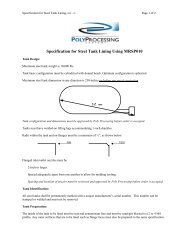Environmental Stress Crack Resistance - Poly Processing
Environmental Stress Crack Resistance - Poly Processing
Environmental Stress Crack Resistance - Poly Processing
Create successful ePaper yourself
Turn your PDF publications into a flip-book with our unique Google optimized e-Paper software.
If then, we continue our visualization exercise and increase the magnification further,we begin to notice that the molecular chains along the boundaries of the regions canhave several different characteristics or types. They can: (1) extend from a crystalregion and terminate in an amorphous region; (2) extend a few molecular lengths intothe amorphous region and then loop back into the original crystal; or (3) transverse anentire amorphous region and then become part of another crystal region. It is nowbelieved that these long molecular chains that link or transverse more than one crystalregion determine the environmental stress crack resistance of polyethylene. These longmolecular chains, sometimes called tie molecules, act as binders between the adjacentcrystal regions.3- Origin of ESCR:To understand stress cracking, we should examine both what it is and where itoccurs. Intuitively we believe that stress cracking is initiated by the breaking of themolecules, particularly the tie molecules. This break is then propagated to form a microcrack that will ultimately grow to form a crack big enough to be seen and cause productfailure. The process of chain breakage or scission is called degradation. There isexperimental evidence showing that crystallinity is slightly increased when polymerdegradation (chain scission) occurs. This is know as Chemicrystallization and it is theprocess by which the chain end that originated from the crystal springs back andreenters the crystal after chain scission of the tie molecules, or degradation, hasoccurred. Chemicrystallisation due to chain scission is a phenomenon that has beenstudied and observed in the degradation of polyethylene due to weathering.This finding suggests that when the molecular chains degrade (break), theysomehow add to the crystalline regions at the expense of the amorphous regions.Therefore, we can conclude that the degradation begins either within the existingamorphous regions and then creates new crystalline regions nearby or, alternately, thedegradation begins at the amorphous/crystalline boundaries and builds onto existingcrystalline regions. It does not begin in the crystalline regions since there would be nomechanism to increase the level of crystallinityIt is more likely that stress cracking occures at the interphase or boundary regionand does not begin in the middle of the amorphous regions. The rational for this is thatthe molecular chains in the amorphous regions are highly entangled, even though theydo not follow a structured pattern. To create new crystals within an amorphous regionwould require very high energy levels to untangle these molecules and make themmobile. The crystallization process in polyethylene requires the polymer to be in amolten state where the molecular chains have a very high degree of mobility.Degradation or chain scission can still occur in the middle of the amorphous region butthis scission is not the dominant factor for the observed increase in crystallinity.Having ruled out the middle of the amorphous and crystal regions as primarylocations for the degradation process, it then must be the interphase region where3
















